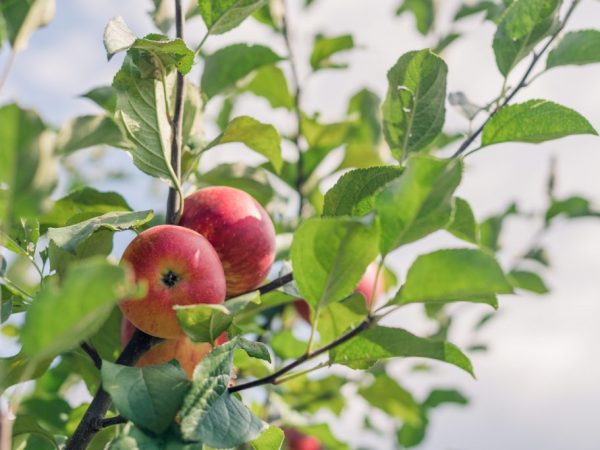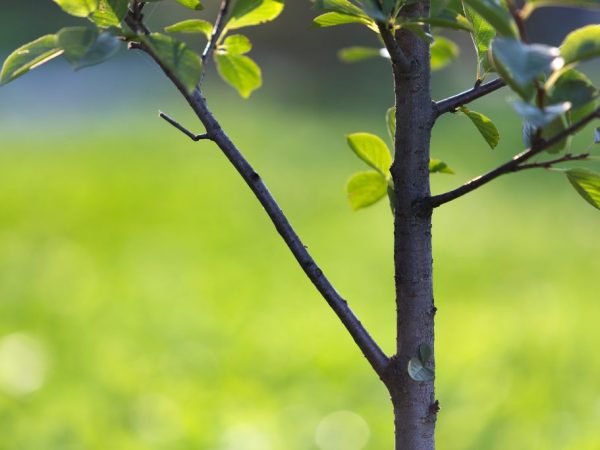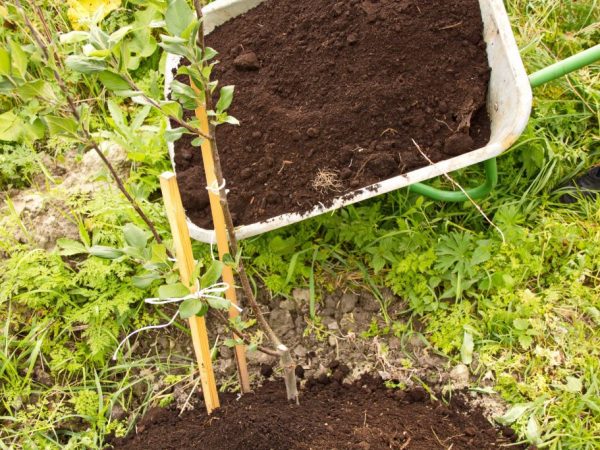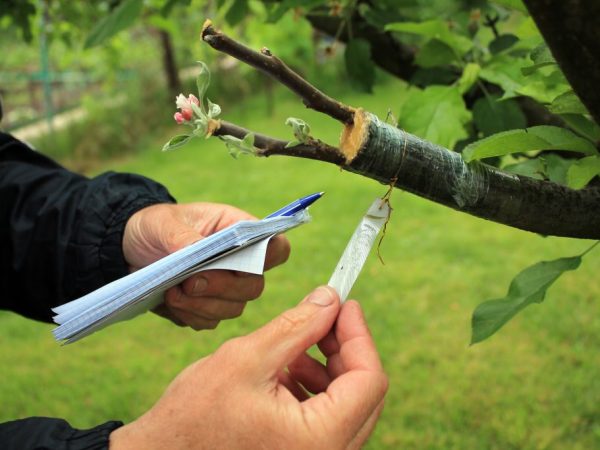Description of the Lobo apple tree
The Lobo apple tree is a winter variety obtained in Canada (Ottawa province) back in 1906. In Belarus, the Baltic States and Ukraine, apples began to be grown in the 20s of the last century, and it was included in the official register of Russia in 1971.
- general characteristics
- Advantages and disadvantages of the variety
- Description of the tree and fruit
- Taste
- Yield
- Pollinators
- Frost resistance
- Disease resistance
- Landing
- Timing
- Site preparation
- Pit preparation
- Landing technology
- Care
- Watering
- Top dressing
- Crown pruning
- Disease and pest control
- Features of ripening and fruiting
- Types of rootstocks
- Growing features
- Output

Description of the Lobo apple tree
general characteristics
Advantages and disadvantages of the variety
The advantages include:
- High yield
- Stable fruiting
- Excellent presentation and taste of apples
- Good transportability
- Drought tolerance
- Frost resistance
The disadvantages of the variety are:
- Sensitivity to scab and powdery mildew
- Short shelf life of products
Description of the tree and fruit
Trees grow intensively in the first years and reach an average height (about 4 m). Then the vegetation speed slows down.
- The crown of a young tree is oval, then it becomes rounded.
- Thickening of the branches is not typical.
- Young shoots are brown with a cherry or purple tint, angular.
- The leaves are bright green, large, resembling an egg or a regular oval in shape.
- The surface of the leaves is dull, wrinkled, with pronounced tuberosity.
- The tip is sharp, sometimes forked or curled.
Description of fruits:
- Average weight 140-180 g.
- The shape is rounded-conical with a weakly pronounced ribbing.
- The main color is yellow-green, the blush is crimson
- White pulp, fine-grained
Taste
Lobo apples are juicy, with tender pulp. The taste is sweet, there is a slight sourness and notes of caramel, the aroma is pronounced, reminiscent of raspberries.
The tasters give the variety up to 4.8 points.
The fruits contain a lot of ascorbic acid, up to 10 mg per 100 g. The amount of sugar is 10-11%, which determines the sweet taste. The titrated acidity is only 0.48%.
Yield

Lobo is suitable for industrial cultivation
One of the main characteristics that gardeners are interested in when choosing a variety is its yield.
Lobo apple trees at their peak of development can give from 180 to 360 kg of fruits from one tree.
In the first years, the yield increases steadily. After 10 years, the fluctuations are insignificant, every year approximately the same number of fruits can be harvested in the garden.
High and stable performance allows growing the variety on an industrial scale.
Pollinators
The tree is practically sterile without pollinators. The pistils are not fertilized with pollen from their own stamens or from the flowers of trees of the same variety.
For normal fruiting in the garden, you need to plant the following varieties:
- Spartan
- March
- Parent Macintosh
- Orlik
- Prima
- Green may
The distance between trees should be 50-150 m. 1 pollinator can be planted on 7-8 apple trees.
Sometimes two species are combined in the garden, which are pollinators for each other.
Frost resistance
Apple trees were bred in northern Canada. Therefore, special attention was paid to their resistance to frost.
It is the frost resistance of the variety that contributes to stable yields. Even in the harsh northern regions, trees do not need to be covered for the winter. The apple tree does not react to sudden changes in temperature.
Disease resistance
The Lobo apple variety is susceptible to fungal diseases. It occurs especially often during rainy summers. Low resistance is observed, first of all, to powdery mildew and scab.
Probably, many have seen the fruit covered with large brown spots. They often fall off and fill poorly. This is scab - a disease that can destroy almost the entire crop.
Powdery mildew appears as a white bloom on the leaves. This reduces their ability to photosynthesize, which also affects the yield. With a massive lesion, the tree may die.
Landing

The yield of the apple tree depends on the correct planting.
In order for young trees to take root and give a bountiful harvest, they must be planted correctly. This takes into account the timing, soil type and technology.
The apple tree does not like the close location of groundwater, therefore it is recommended to plant it on hills.
Timing
You can plant the Lobo apple tree in autumn or spring. Since the variety is more commonly grown in northern regions, many prefer spring planting. It is carried out when the ground is completely warmed up (from mid-April to mid-May).
In autumn, it is better to plant cuttings from late September to mid-October, so that by the first frost they are well strengthened and rooted.
Site preparation
You need to prepare the site a few weeks before planting. If it is planned in the spring, then all manipulations are carried out in late autumn, in the last days of October. Fertilizers must be applied to the land on the site.
For m² you will need:
- Humus, compost or manure - 5-8 kg
- Peat - 8-10 kg
- Superphosphate - 100 g
- Potassium sulfate - 40 g
- Potassium salt - 45 g
These fertilizers are applied to the dug soil, from which all weeds are removed. In the fall, you can leave the turf, which will rot until spring and turn into fertilizer itself.
If the soil in the garden is too acidic, liming is carried out with dolomite flour or slaked lime. It is important to remember that you cannot apply manure, phosphorus fertilizer and lime at the same time. These components will react with each other and spend useful properties. Better to take a break between them for a few weeks.
Pit preparation
When the ground is prepared, they dig a hole. Its dimensions should be 1 × 1 m. A fertile layer is separated from the soil obtained after digging. It is mixed with fertilizers:
- Humus - 2-3 buckets
- Peat crumb - 3-4 buckets
- Superphosphate - 1 kg
- Wood ash - 1 kg
The resulting mixture is poured into the bottom of the pit and left for 3-4 weeks (for spring planting for the winter).
When the place is ready, proceed to planting a tree.
Landing technology

A young seedling must be tied to a support
The technology looks like this:
- Carefully examine the root system, remove broken and diseased roots
- A peg with a height of about 2 m is driven into the bottom of the pit
- A mixture of soil and fertilizers at the bottom is formed in the form of a mound
- Gently spread the roots over the mound
- Sprinkle the hole on top with fertile soil
- Tie a seedling to a peg
- Pour in 2-3 buckets of water
If the tree is planted in the fall, it should be wrapped in plastic to protect the bark from frost and rodents. The distance between the seedlings should be about 4 m.
Care
For good growth and abundant fruiting, Lobo apple trees need to be properly cared for. She needs timely watering, fertilizing, crown pruning, disease prevention and pest control.
Watering
The variety is drought-resistant and does not like waterlogging. Therefore, you need to water it no more than 3 times per season.It is advisable to do this before flowering, during the period of ovary formation and fruit pouring. It is important to monitor the weather; in a rainy summer, the amount of watering can be reduced.
From 4 to 10 buckets of water are poured under one tree, depending on the age and degree of soil moisture.
Top dressing
Most of all, young seedlings need feeding during the first six years after planting. In the spring, liquid nitrogenous fertilizers are applied. After that, the tree is immediately watered, the amount of water should be 2 times more than fertilizer.
In the second half of summer, the tree needs potassium and phosphorus to prepare for winter. During the season, it is fed 5 times, the last time - at the end of July.
Adult apple trees can be fertilized 3 times per season, 2-3 days before watering. In spring and early summer, nitrogenous fertilizers are applied, and in the second half of summer - potash and phosphorus fertilizers. Such care allows you to significantly increase the yield.
Crown pruning
The Lobo variety has a liquid crown that does not need intensive thinning. In young apple trees, it is formed in such a way that it does not stretch too much. This greatly facilitates further care and harvesting.
In early spring, the tree is examined, broken, frozen and deformed shoots are removed. This home pruning is called sanitary pruning.
Disease and pest control

Preventive measures will help keep the tree healthy
Gardeners recommend first of all to do the prevention of scab and powdery mildew.
For this, in early spring and after flowering, trees are treated with antifungal drugs Skor, Horus, copper sulfate, urea, Bordeaux liquid. In this case, urea also serves as a foliar feeding, it is used during the formation of ovaries.
To control pests, it is necessary to use insecticides. Now chemical agents are being successfully replaced with harmless biological products, for example, Zircon. Folk remedies are also used - infusions of calendula, dill, tobacco, onions, garlic, soap solution.
Features of ripening and fruiting
According to the description, Lobo is an intensive type variety that begins to bear fruit early and increases yield quickly. The timing of the onset of fruiting largely depends on the stock. Most often, a full harvest is obtained in 3-4 years.
In the first 2-3 years, it is recommended to pick off flowers so that the tree does not deplete. With too abundant flowering in the 4th year, the ovaries are thinned out.
Flowers develop on last year's shoots. Intense flowering occurs at the end of May. Apples are poured all summer, at the end of September they begin to gradually turn red. The blush is always more intense on the south-facing fruit. The liquid crown transmits light well, so most apples ripen at the same time.
In fruitful years, tree branches have to be propped up; they can break under the mass of fruits even before they are fully ripe. Harvesting begins in early October. It is advisable to finish it within a week.
Apples are carefully removed from the branches and placed in cardboard boxes, separating from each other with dry cane, shavings or paper. Store in a cool place.
The keeping quality of the variety is low, you can eat the fruit until the beginning of January. Gardeners who grow apples in large quantities try to sell their products immediately. The fruits are juicy, so processing plants are happy to buy them. They are used not only for the production of juice, but also for compotes, jams, and jam.
Types of rootstocks
There are such varieties:
- Dwarf hybrids. The height of the tree is 2-3 m, the crown immediately becomes round and does not change with age. Fruiting already 2-3 years after planting, life expectancy 20-25 years.
- Semi-dwarf. It grows up to 3-3.5 m, begins to yield in 2-3 years. Productivity lasts 30-40 years.
- Columnar. Option with a very narrow crown. The trunk is covered with ringlets, on which the fruits are formed.The tree takes up little space in the garden, it practically does not require pruning, it begins to produce crops in the second year after planting. The maximum age of productivity is 12-15 years.
- Stanzovy. A special type of creeping apple tree. The trunk of the tree is elastic, it grows almost on the ground. The height of the tree is only 45-50 cm, the crown can be formed in the form of a plate, almost completely lying on the ground. The variety is fruitful, the fruits from it are very easy to collect. The beginning of productivity is 2-3 years, life expectancy is up to 20 years.
The choice of stock depends on the size of the garden and the purpose of the cultivation. In household plots, cuttings are often planted on a semi-dwarf.

The type of rootstock depends on the size of the plot
In large industrial gardens, dwarf and columnar species have become popular. They begin to bear fruit quickly, they are not tall, which makes it easier to pick fruit.
Recently, more and more attention is paid to stlate rootstocks, which are distinguished by high productivity.
Growing features
The Lobo apple tree is well adapted to northern and temperate climates. She loves fertile soil, which also affects the characteristics of her cultivation in different regions.
In Russia, the tree is suitable for the Central Black Earth region, it also takes root well in the Lower Volga region due to its drought resistance.
The variety has gained popularity in other areas as well:
- Voronezh
- Lipetsk
- Tambov
- Orlovskaya
- Belgorod
Winter hardiness allows planting it beyond the Urals, for example, in Omsk and Yekaterinburg. In the Moscow region, the variety is grown without shelter for the winter.
The meager lands of the Leningrad region are not very well suited for the variety. Here it is imperative to apply fertilizer under the tree. it is best to fill the pit with purchased fertile soil, manure and low-lying peat.
In cold regions, the ripening period may slow down; products are received at the end of the first decade of October.
The apple tree is grown in almost all regions of Central and Western Ukraine, in the Belarusian Polesie, Lithuania and Latvia.
Output
The Lobo variety is liked by many gardeners. It has excellent taste and good, stable yield. The care is standard and does not require any extra effort.
When planting, it is imperative to follow the technology and take into account that apple trees are demanding on the composition of the soil. But you don't have to worry that the tree will be destroyed by drought or frost.

